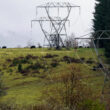Megan Sanderson
For The New Era
For the Sweet Home boys Portland to Coast team, the breakdown of one of their two vans right at the start of the 130-mile relay road race was only the beginning of it all.
The Portland to Coast relay run for high-schoolers has 24 legs, starting in Portland and ending in Seaside. The race is run in conjunction with the Hood to Coast Relay, both of which started this year on Aug. 26.
Each team consists of 12 members, each runner, running at least two legs for the Portland to Coast race and three for Hood to Coast. Each team also has two vans to carry teammates not currently running and drop them off at the proper baton exchange spots along the route.
The boys’ high school team consisted of runners from Sweet Home, East Linn Christian Academy, Junction City and Central boys. Sweet Home boys on the team included captain Nick Hall, Daniel Danforth and Ian Wingo.
Shortly after starting their second leg of the race, the boys’ first van broke down; the fan belt had been shredded. The team started looking for answers.
“You can’t fit 12 runners and two drivers in one van,” said Billy Snow, a driver for the boys’ team. “Can’t do it.”
Luckily for the boys, Scott Swanson, driver for the Sweet Home team, drove past the boys’ broken-down rig and was able to take someone to go get another belt. With luck even more on their side, a mechanic shop was right where the van had broken down. Within minutes, the van was back on the road again.
Not even five minutes later, the van had broken down once again.
“Maybe God was trying to tell us something,” said Snow.
The drivers tried to borrow as well as rent a van, but were unsuccessful. Swanson provided help once again, by taking the next set of runners to the next exchange spot, allowing the boys to continue on with their race.
Trying to figure out how to get the runners for the next leg to each designated exchange spot, Snow drove each one individually to their spot. However, another problem developed. Organizers had added 250 teams to the Hood to Coast relay, which was being run simultaneously, and the extra 500 vans resulted in traffic jams at nearly every exchange point as the race progressed from the highways onto smaller country roads through the Coastal Range. A trip that normally would have taken an hour required four.
Knowing that they could not come back to pick up finished runners due to traffic, the boys had to hitch rides from other teams.
Boys who hitched rides ended up catching up to Snow and his van, faster than he was dropping runners off. It was obvious the drop-off system wasn’t going to work. Team members sat downto figure out what to do. Finally, the decision had been made. They were all simply going to have to fit into one van. The next 12 legs of the race were run like that.
“But that wasn’t the end of it,” said Snow.
During Hall’s second leg, he collapsed due to dehydration and was sent to a hospital in Astoria, posing another problem for the team.
“People were being driven off in ambulances,” Hall Said. “It happened to all sorts of people, not just me.”
Again, fortunately for the boys, Rachel Sanders, mother of Paige Sanders, a runner on the girls’ team, offered to pick Hall up from the hospital. Then to top it all off, Wingo developed an upset stomach, forcing other team members to run another leg.
“We would have ran four hours faster” if the team had not encountered all the setbacks, Snow said.
However, the boys team had been seeded in last place and finished fourth.
“I don’t know how they did it,” Snow said.
The girls team, which finished third after winning last year, and the Sweet Home women’s Hood to Coast team, The Valley Girls, who ran three legs each to cover the 200 miles from Mt. Hood to Seaside, did not experience problems as severe as the boys did, but it wasn’t smooth going.
“The traffic was horrible,” said Paige Sanders, who has run the race three times for the girls team. “They should’ve limited the teams, but it was a very memorable Portland to Coast for sure.”
The Valley Girls were not hurt in their times because of the backups. Dave Bauer, a driver for The Valley Girls, said that he believed the increase in the amount of teams was what created the backups.
Several runners from both the Valley Girls and the girls team, named the Runnin’ Yayhoos, had to get out of their vans and run to their exchange spot to be there in time to take the baton from the incoming runner.
“As soon as we dropped the runner off, they had to be ready to go,” said Bauer. “There was no time to take care of the runners.”
Despite the complications, many of the runners enjoyed their experience.
“Sometimes I just wanted to go home, but we all decided it would be best to finish the race as well as we could,” Wingo said.
Official results were not yet available early this week, but the boys were unofficially fourth in a field of more than 20 teams and the girls third in a field of five.
The Valley Girls were 715th overall, finishing in 30:30.42.
For the boys, their goal was simply to finish.
“If Seaside falls off of the face of the earth, we’ll get there and finish,” Snow said.





